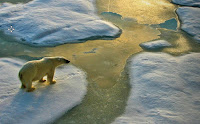 |
| Dr. Hui Zhao and Dr. Benjamin Tayo |
A unique partnership has formed between, Dr. Benjamin O. Tayo Assistant Professor of Physics at Pittsburg State University and Dr. Hui Zhao, Associate Professor of Physics and Astronomy at the University of Kansas as part of the educational outreach initiatives funded by the NSF EPSCoR grant titled "Collaborative Research: Imaging and Controlling Ultrafast Dynamics of Atoms, Molecules, and Nanostructures", #1430519. This educational initiative provides funding support for a small college physics faculty member to work closely with one of the key researchers on the grant project. Their educational plan involves collaborating on research, co-authoring any publications that may result from their research and developing related curriculum to enhance Pittsburg State’s physics curriculum.
 |
| Dr. Zhao conducting experiments in his lab |
Their research focuses on the theoretical studies of the electronic and optical properties of two-dimensional crystals. In particular, Tayo has been working on modeling the properties of the W1-xMoxS2 alloy as a function of the composition x. He surmised "that being able to characterize the electronic properties of this alloy for composition x could possibly lead to advanced functional materials with properties superior to that of the individual materials MoS2 and WS2." Zhao added, “We are performing experiments to be compared with the model. This will help understand electronic states in these alloys. Such knowledge contributes to the goal of controlling electrons in these materials with light.” Furthermore, he emphasized “this collaborative research clearly aligns with the emphasis for the Thrust 2 research effort of the grant directed at two-dimensional materials.” Zhao will perform experimental studies as part of their proposed research activities. Tayo will provide theoretical and numerical capabilities to improve the understanding of these properties that will enhance the impact of the collaborative work. They both hope “to find new ways of controlling the electronic and optical properties of 2D materials” using theoretical calculations to explain and complement the experimental findings. From this collaborative research project, they hope to use their data tested theories in future studies and experiments.
Students have also benefited from this collaborative initiative. Each professor has had the opportunity to involve a graduate student in the project. Tayo’s graduate student worked with him throughout the summer, and although his graduate student found the research a little challenging, it has sparked his interest in the field. As a result, Tayo's graduate student enrolled in a topics class titled “Density Functional Theory” to improve his understanding of electronic and optical physics. With this enhancement of his knowledge base, he can then start performing some calculations for the experiments. Zhao is also supporting a graduate student who is performing the related experiments
Tayo summarized the experience so far by saying:
I am grateful that by means of this collaboration, I was really busy last summer carrying out research. The knowledge gain so far has helped me a lot and it’s very useful for the students as I incorporate some of the knowledge into my teaching. I would strongly recommend the program to my colleagues because being active in research really enhances the depth of your knowledge and makes you to become a better teacher.
And Zhao added:
The goals were to involve faculty members from small colleges in cutting edge research that would eventually transfer benefits to their students. The theory-experimental collaboration model is a perfect way to accomplish this since it doesn’t require facilities from the small college partner.
Tayo and Zhao will continue their collaboration throughout the remainder of the academic school year.
The Kansas and Nebraska NSF EPSCoR Imaging and Controlling Ultrafast Dynamics of Atoms, Molecules, and Nanostructures, #1430519 Track 2 Grant is designed to enhance STEM education in Kansas by supporting activities that will lead to an expanded STEM workforce or prepare a new generation for STEM careers in the areas of atomic/molecular/optical science.









